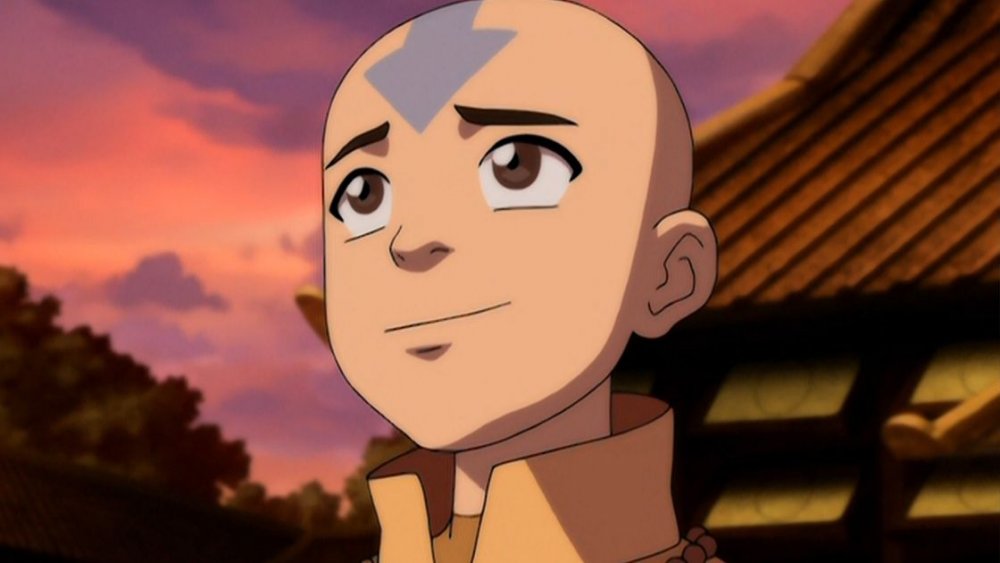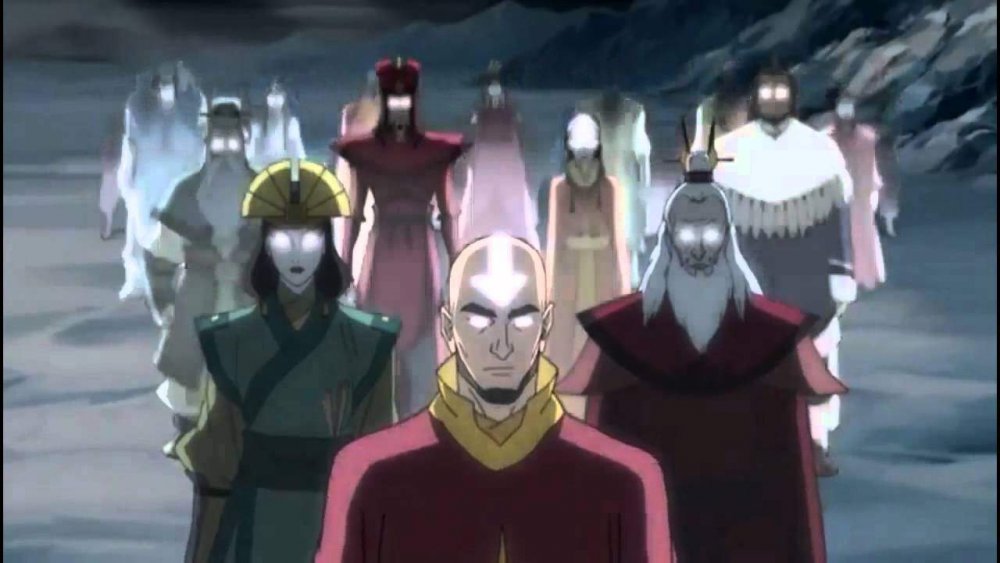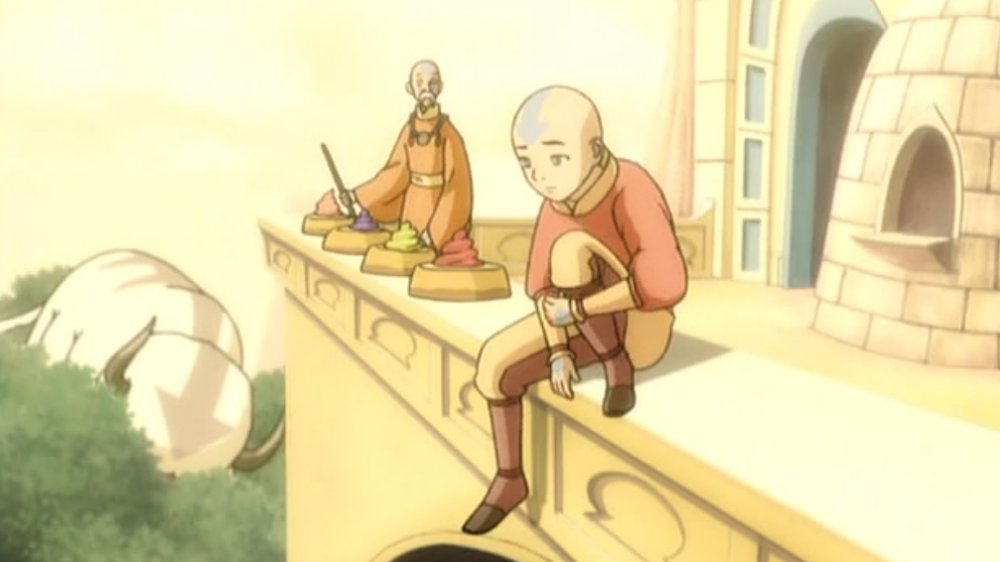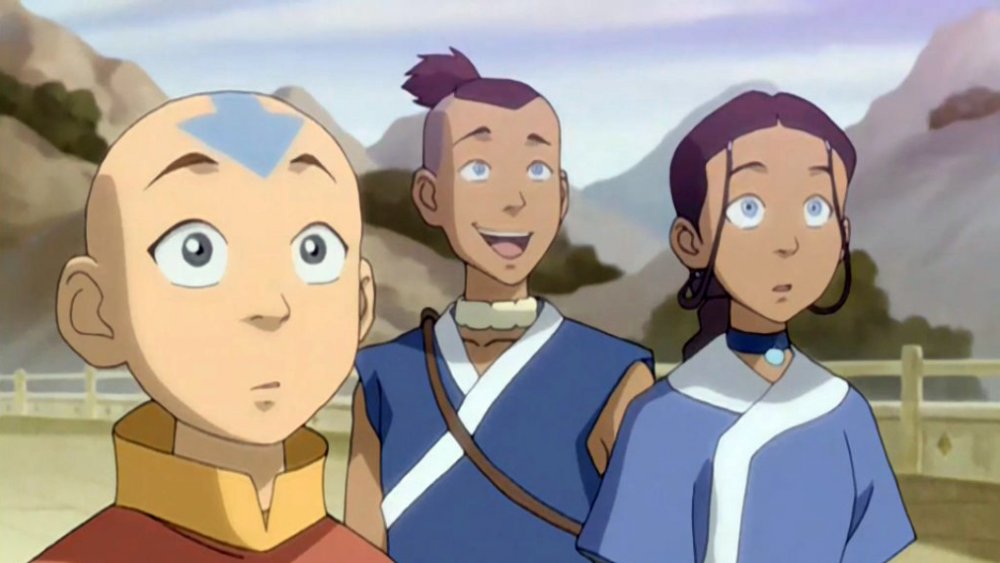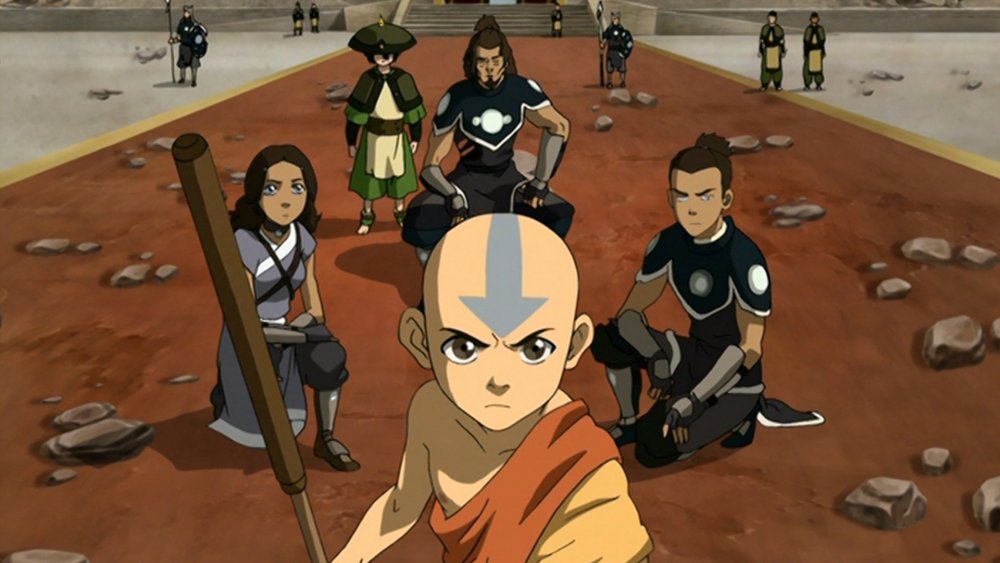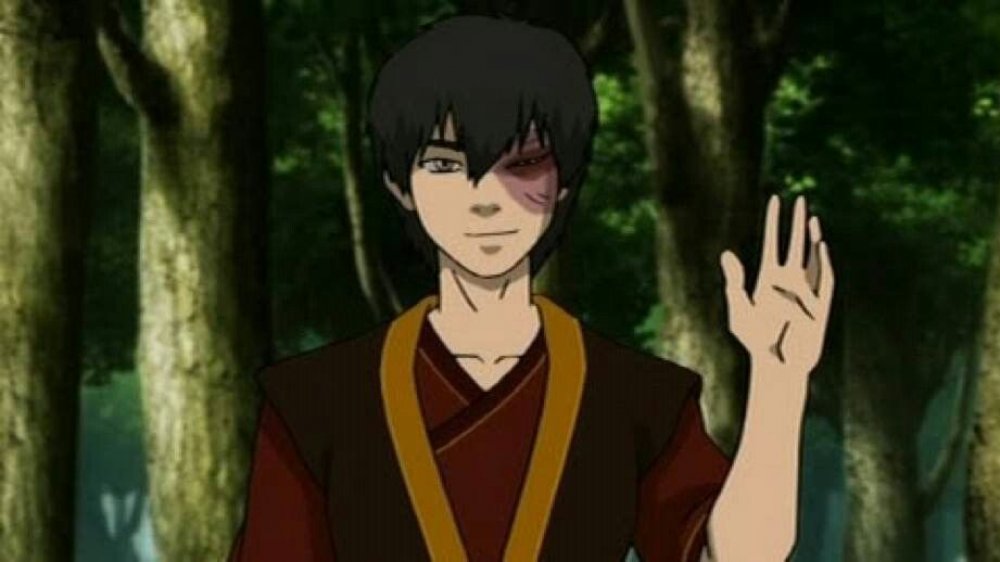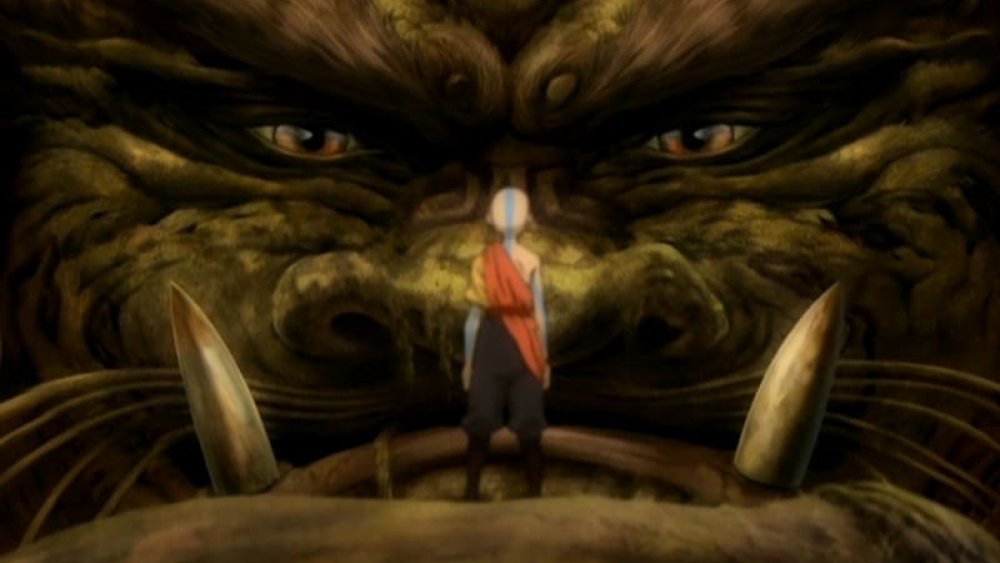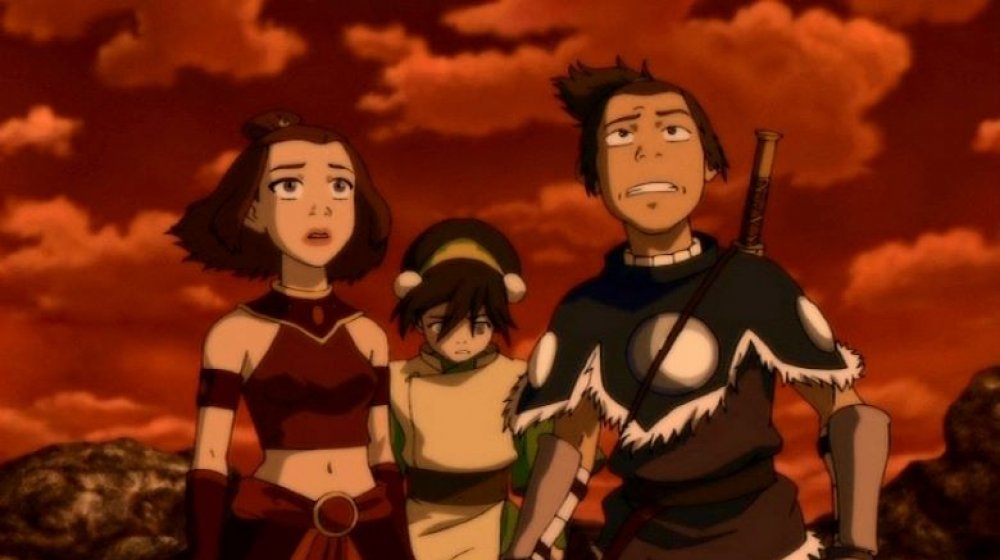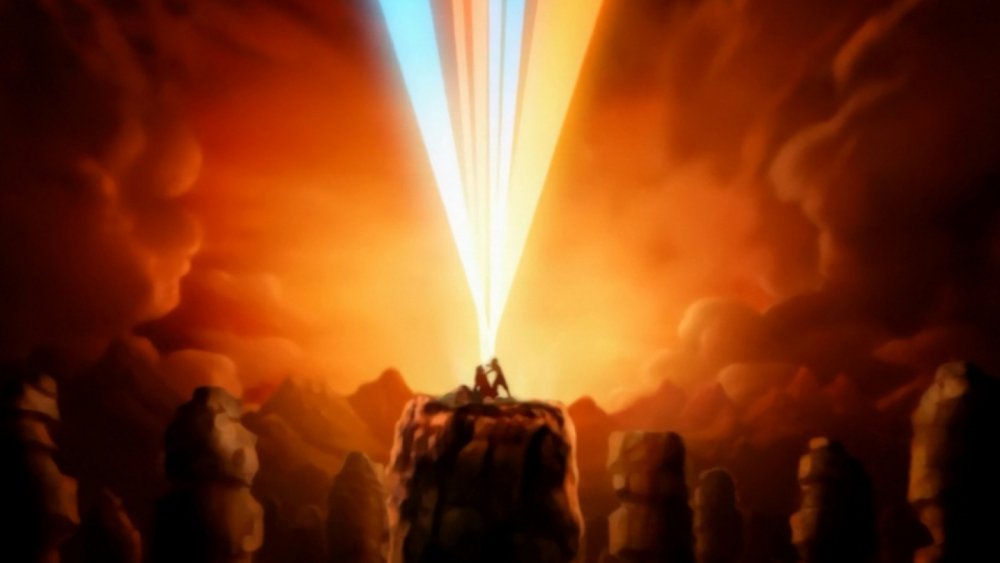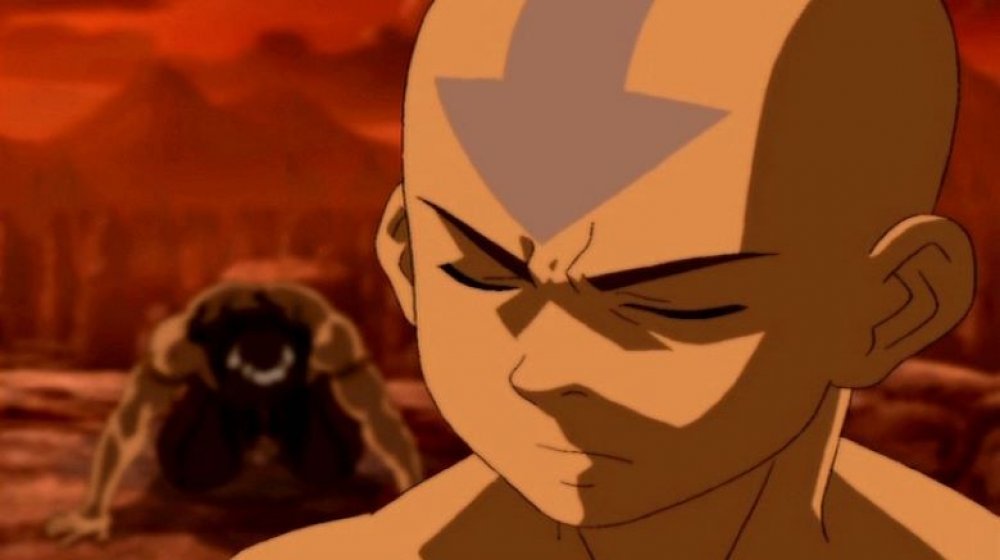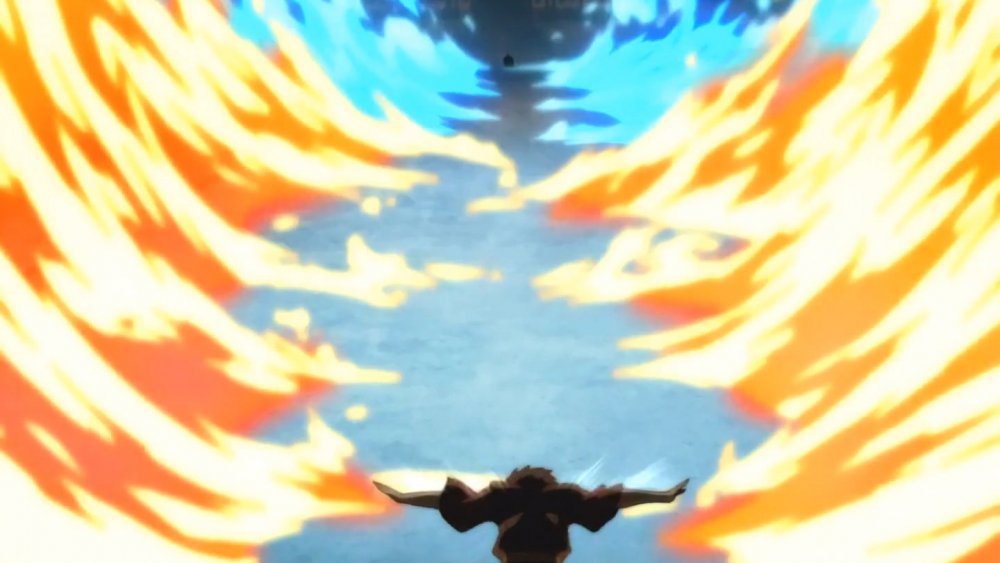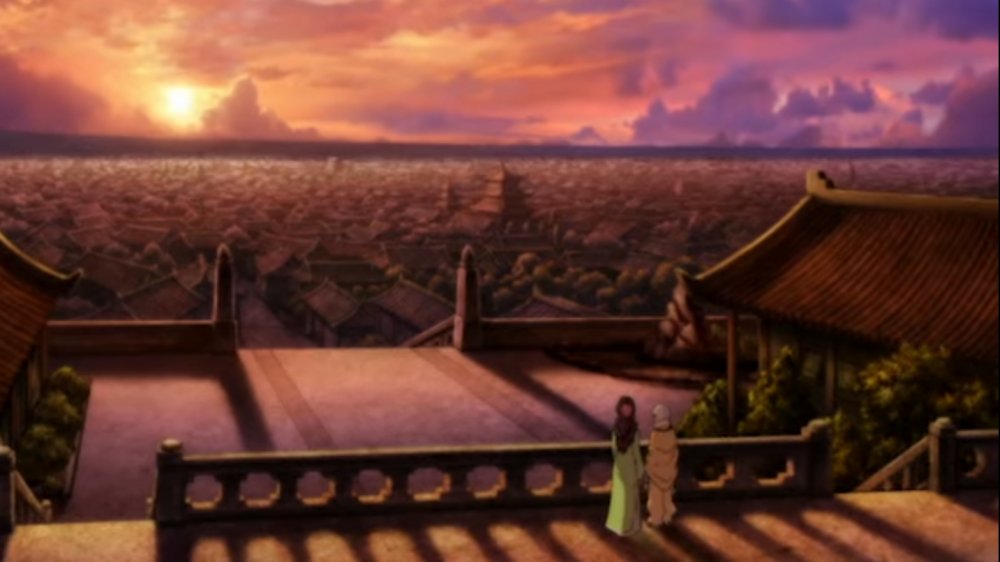The Ending Of Avatar: The Last Airbender Explained
With its inclusion on Netflix in May 2020 and immediate popularity on the streaming platform, it's safe to say Avatar: The Last Airbender has stood the test of time since airing on Nickelodeon 15 years ago. Fans old and new can recite the opening forwards, backwards, two times fast, in other languages — you name it. They're as dedicated as cabbage merchants.
Why wouldn't they be? Avatar has so much to offer despite being a kids' show at heart: Commentary on war, nationalism, and pride focused through the lens of intricate story arcs and steeped in East Asian values, deeply lovable characters who grow and change by interacting with each other and the world around them, and some of the most beautifully animated and orchestrated scenes in television history. "Masterpiece" doesn't cut it.
What's truly amazing, however, is that after setting incredibly high expectations early on, Avatar delivers in every way: Themes, fights, character beats. Quite a lot happens, so we're going to discuss what leads up to the conclusion, how things play out in the finale, and what we think it all means.
The Avatar, master of all four elements
The premise of Avatar's world is a simple one: There are four nations, and depending on where a person is born, they may have the ability to "bend" one of the elements. Those of the Water Tribe control the waves, citizens of the Earth Kingdom can toss around rocks like they're papier-mâché, Fire Nation hotmen and hotwomen burn up the competition, and the monks and nuns of the Air Nomads blow away their worldly concerns.
Then there's the Avatar: Master of all four elements, bridge between the physical plane and the Spirit World. The Avatar is a singular entity, reincarnated into a person from one of the four nations (in a predetermined order) every time the previous version dies. Whatever role each new Avatar ends up playing, they're always the center of attention in the world, as important to international affairs as any high-ranking politician or monarch.
The most powerful ability the Avatar has at their disposal, however, is the Avatar State. Under its influence, the current Avatar is able to draw upon the knowledge, experience, and power of all their past lives — a devastatingly powerful tool whether controlled or let loose. The one drawback is that if an Avtar is killed in the Avatar State, the Avatar cycle will come to an abrupt end. It's a great deal of power, but at a price.
Aang learns he's the Avatar
The Avatar normally learns of their position once they reach 16, but with an impending war just over the horizon, the Air Nomads agreed to tell Aang, the Avatar's newest incarnation, of his burden at the ripe age of 12. Though a supremely talented airbender for his age, Aang lived an otherwise regular life up until that point, eating (and occasionally launching) fruit pies, engaging in friendly games of airball, and flying around with Appa, his sky bison. So naturally, the news — destiny? global conflict? Avatar? — threw him for quite a loop.
Afraid and confused like any kid would have been, Aang ran from his newfound responsibility, barreling straight into a storm while atop Appa. Nature's brew proved too much for the two of them, however, sending Aang into the Avatar State, in which he enveloped himself and the sky bison in an iceberg beneath the waves, essentially putting them in cryosleep. They would remain that way for the next hundred years.
And so it was that, for all intents and purposes, the world was without an Avatar for an entire century, in which time war finally did arrive. Under Fire Lord Sozin and the might granted to all firebenders by a passing comet (later dubbed Sozin's Comet), the Fire Nation expanded its flaming tendrils the world over. Seeking an Avatar they didn't know had fled, the Fire Army's first and cruelest act was to wipe out the Air Nomads, completely and utterly.
Aang must defeat the Fire Lord
As luck would have it, Southern Water Tribe siblings Sokka and Katara discover Aang in the ice while out fishing one day. By all appearances, he's just a kid who wants to have fun, but it isn't long before Prince Zuko crashes the party (for the first of many times) and Aang's true identity comes to light. Not long after that, the whole world knows of his return.
The thing is, after connecting to and speaking with the spirit of Roku, the Avatar preceding him, Aang learns that he's on something of a time limit. He must defeat the current Fire Lord, Ozai, before Sozin's Comet returns the following summer and allows the Fire Nation to wreak unstoppable havoc once again. Committing genocide once is enough, but with the ability to potentially repeat it ...
From that point forward, Aang has no choice but to face his destiny as the Avatar and put an end to the fiery tyranny, even if it is a hundred years too late. Having already mastered airbending, he sets out — with Sokka and Katara's help — in search of waterbending, earthbending, and firebending teachers to prepare himself for the inevitable showdown with Ozai.
Amidst countless adventures that introduce him, Sokka, and Katara to new places and companions — most notably Momo (a winged lemur), Toph (who teaches Aang earthbending), and Suki (a great warrior and Sokka's one true love) – Aang slowly but surely comes into his own, understanding not only how to manipulate elements other than air, but what it truly means to be the Avatar. None of it's easy, but having run away in the past doesn't mean Aang isn't one tough kid in his own way.
Invading the Fire Nation
One of the most important pit stops along the way is Wan Shi Tong's Spirit Library, almost completely sunken beneath desert sands. Among the archives, Team Avatar stumbles across the Fire Nation's Achilles' Heel: The date of the next solar eclipse, the Day of Black Sun, which will leave firebenders powerless the world over. What better opportunity to invade their shores and defeat the Fire Lord?
It takes months of planning, preparation, and surmounting countless obstacles — including a near-defeat at the hands of Zuko's deadly sister, Princess Azula, that seemingly severs Aang's connection to the Avatar State — but by the eclipse, all the pieces are in place. With an army of earthbenders and waterbenders, submersible vehicles to avoid early detection, and a well-trained Avatar, things go well at first. The march towards the Fire Lord is slow and steady, but progress is made.
In the meanwhile, Aang, Sokka, and Toph branch off to find Ozai, only Azula is waiting for them instead, and she distracts them long enough that the eclipse ends and firebending returns, forcing them to retreat.
It's none other than Zuko who discovers Ozai's location — Zuko, who for longer than Aang's been out of the iceberg, has been struggling to find his true self.He speaks his piece, but believes that defeating the Fire Lord is the Avatar's destiny, not his own, and so he leaves, but not before Ozai tries to finish him off with lightning, which Zuko redirects thanks to his uncle Iroh's training.
The day is lost, but much comes of it.
Aang finds his firebending teacher
Team Avatar falls back to the Western Air Temple, where deciding on a next course of action becomes imperative. The eclipse has passed, so as Sokka says to Aang, "The new plan is the old plan! You just need to master all four elements and confront the Fire Lord before the comet comes." That's easier said than done, especially since Aang is still without a firebending teacher ... until Zuko arrives, that is.
As they've fought the firebender more times than they can count, it's only natural that everyone's knee-jerk reaction is to get defensive. Suffice to say, the conversation doesn't go well, and Zuko accidentally burns Toph's feet when she comes to talk to him alone later that night. It really couldn't get any worse — that is, until Combustion Man, an assassin who's been after Aang for some time, throws things into disarray.
Although it's Sokka who ultimately bests the daunting killer, Zuko alerts everyone to his presence, essentially saving them from an early grave. Once the dust settles, the firebender comes down to plead Team Avatar's graces one last time. Aang believes Zuko to be genuine, and asks if his friends think the same. One by one, they accept Zuko as Aang's firebending teacher — even the not-so-subtly reluctant Katara. Regardless, Aang is now one step closer to becoming a fully-realized Avatar.
Does Aang need to kill the Fire Lord?
As Sozin's Comet draws ever closer, Aang grows ever more terrified of what he must do: Kill the Fire Lord. Raised among the Air Nomads, the Avatar is a pacifist by nature; when push comes to shove, his fighting style relies more on evasion and tricks than direct confrontation. He goes so far as to propose waiting until after the comet to battle Ozai, as he doesn't feel confident enough with all the elements yet. Only Zuko's premonition that the Fire Lord will raze the Earth Kingdom using the comet's power convinces Aang to stop running.
Still, killing Ozai still doesn't sit well with the airbender. He falls asleep while meditating on a solution, only to wake up on an unfamiliar island where he decides to ask his past lives for advice. Talking to the spirits of Avatars Roku, Kyoshi, Kuruk, and Yangchen does nothing to help him, however, as they all believe Ozai needs to die. What is he to do?
While still pondering, Aang discovers that the island is actually a living thing: a lion turtle, among the oldest and most spiritual creatures in the Avatar universe. The great beast grants Aang's request for wisdom by bestowing upon him something beyond the four elements: Energybending, the power to take someone's bending away. Ozai doesn't need to die, after all.
A three-pronged final battle
The final showdown takes place on three fronts: (1) Katara and Zuko versus Azula; (2) Sokka, Toph, and Suki figuring out how to immobilize the Fire Army's airships; and of course, (3) Aang taking down Fire Lord Ozai (The Order of the White Lotus, led by Iroh, has the more standard troop-to-troop warfare covered). Only by using all the skills, knowledge, and wisdom they've acquired over the course of Avatar's three seasons — not to mention keeping their mistakes from the eclipse invasion in mind — do any of them stand a chance.
Azula is in a frail state of mind before Katara and Zuko even arrive, having been crowned the new Fire Lord after Ozai declared himself the Phoenix King, and having seen visions of her long-disappeared mother. As if Azula isn't dangerous enough already, a she proves a horrifying opponent, blasting her blue flames with reckless abandon and shooting lightning like she's a thundercloud. The bending battle ends in the heroes' favor, but not without a new scar with which for Zuko to live.
Sokka, Toph, and Suki have a rough time of it as well — anyone would, coming up against a fleet of humongous airships — but between Sokka's tactical thinking, Toph's metalbending prowess, and Suki's unmatched hand-to-hand combat, they give Aang one less thing to worry about by taking control of and all but destroying the flying war machines.
All that's left is for the Avatar to pull out a victory against the Sozin's Comet-powered Ozai.
An ending and a beginning
As feared by Aang, the raw power Sozin's Comet gives Ozai proves to be no joke, each flame blast scarier than the last. At one point, Ozai hits Aang so hard that the Avatar collides with a jutting rock, the point of contact right where Azula left him with a nasty scar months before. Thus, the Avatar State is triggered.
If Ozai had Aang on the ropes earlier, then this is a complete reversal. Summoning all four elements, the Avatar becomes a force of nature against which, Sozin's Comet or no, Ozai pales. Grasping hold of himself, Aang extinguishes the Avatar State just before landing a final blow. He quickly subdues a weakened Ozai and uses energybending, taking the power-hungry man's bending away for good.
The Fire Nation, of course, needs a new leader with Ozai incarcerated, and there's no better man than Zuko for the job. With the Avatar's help, he promises to begin marshaling the world towards an era of peace. There's much to do on that note, and there are questions that still need answering, but for the moment, Aang and his friends take a well-earned rest. As he and Katara share a long-awaited kiss, it feels as though, indeed, peace really is just over the horizon.
The path of mercy
Energybending could understandably be viewed as deus ex machina — a power Aang conveniently receives that prevents him from having to make an actual decision. It's not, however, quite that simple or contrived. Instead, it's a deliberate and considerate move on the writers' part.
Throughout Avatar, Aang's deep connection with nature is made abundantly clear. There's his stance as a vegetarian. There are his relationships with both Appa and Momo, from whom he's inseparable. There's his part in "The Tales of Ba Sing Se" episode, in which he earthbends a wide-open space in which for formerly caged or cramped animals to live. The list goes on, and it's completely opposed to the Fire Nation's constant disregard of the natural world — on full display when Sozin's Comet arrives and Ozai begins burning down a forest.
Even before Aang realizes the lion turtle is a living creature, such a picturesque island is the perfect place for him to root himself in nature once again as he seeks a way to resolve things peacefully. He doesn't just breathe the fresh air and hope an answer comes to him, either — as aforementioned, he reaches back to previous Avatars, and as they tell him, one by one, that he has no choice but to kill, he continues to argue, to strive to be better.
That's how he earns energybending: By refusing to give up on his ideals even when all voices speak to the contrary. What would have been the point if, after three seasons of pacifism, Aang struck down Ozai? His character arc would've meant nothing. It was more than a gift from the lion turtle, more than destiny. It was the end of a path Aang forged himself, and from which he never deviated.
Zuko finds himself
Zuko's character arc is fulfilled as well, though in a way that's more immediately obvious. Challenging Azula to an Agni Kai — a one-on-one firebending duel — is much more than a fight to stop her. It's a clash of ideals, just as is Aang versus Ozai. Zuko spends the entirety of the show running through a series of complex changes, from Avatar hunter to lone wanderer to firebending teacher and everything in between, and it all comes to a head here. This is how he can answer two foundational questions Iroh asked him long before, centered around the identity crisis he's always faced: "Who are you? And what do you want?"
Azula was never one to play fair, however, and when she shoots lightning at Katara, who's watching the battle from the back at Zuko's request, he's grievously wounded protecting her. It's up to the waterbender to finish the fight from there, but in the act of defending her, Zuko decides something without even realizing it: That protecting one's honor shouldn't supersede protecting those you love. It speaks to the person he's become, as well as the person he's going to be. That's a good thing, too, because having another conquest-minded Fire Lord wouldn't do much to actualize Aang's victory.
Avatar: The Last Airbender and change
Indeed, no character closes out as they began. Katara goes from a self-taught waterbender emotionally charged by the death of her mother to a waterbending master who embraces forgiveness. Sokka goes from a half-decent goofball warrior to a well-trained and capable leader (who's still occasionally a goofball). Toph goes from an immensely powerful earthbender who can't see outside of herself to someone who understands not only the earth beneath her feet, but the people around her.
Change, Avatar seems to say, is inevitable. Those who resist it or those who try to enforce it through violence never last long in the grand scheme of things. All the main characters are still young; they will continue to change beyond the confines of the show (and the comics, which continue their stories for a few more years).
And that's a beautiful thing.
